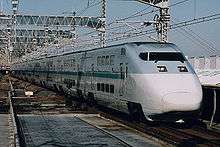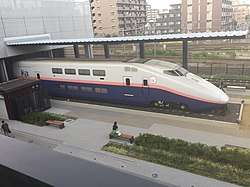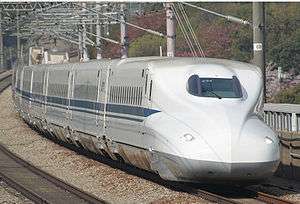E1 Series Shinkansen
The E1 series (E1系) was a high-speed Shinkansen train type operated by East Japan Railway Company (JR East) in Japan from July 1994 until September 2012. They were the first double-deck trains built for Japan's Shinkansen. They were generally, along with their fellow double-deck class the E4 series, known by the marketing name "Max" (Multi-Amenity eXpress).[1] The fleet was withdrawn from regular service on 28 September 2012.[2]
| E1 series | |
|---|---|
 E1 series train set M5 in September 2012 | |
| In service | July 1994 – September 2012 |
| Manufacturer | Hitachi, Kawasaki Heavy Industries |
| Family name | Max |
| Constructed | 1994–1995 |
| Refurbished | 2003–2006 |
| Scrapped | 2012 |
| Number built | 72 vehicles (6 sets) |
| Number in service | None |
| Number preserved | 1 vehicle |
| Number scrapped | 71 vehicles |
| Formation | 12 cars per trainset |
| Fleet numbers | M1–M6 |
| Capacity | 1,235 |
| Operator(s) | JR East |
| Depot(s) | Sendai, Niigata |
| Line(s) served | Tohoku Shinkansen, Joetsu Shinkansen |
| Specifications | |
| Car body construction | Steel |
| Car length | End cars: 26,050 mm (85 ft 6 in), Intermediate cars: 25,000 mm (82 ft 0 in) |
| Width | 3,430 mm (11 ft 3 in) |
| Height | 4,493 mm (14 ft 9 in) |
| Doors | Two per side |
| Maximum speed | 240 km/h (150 mph) |
| Traction system | (AC) MT204 (24 x 410 kW) |
| Power output | 9.84 MW (13,200 hp) |
| Acceleration | 1.6 km/(h⋅s) (0.99 mph/s) |
| Electric system(s) | 25 kV AC, 50 Hz, overhead catenary |
| Current collection method | PS201 pantograph |
| Bogies | DT205 (motored), TR7003 (trailer) |
| Safety system(s) | ATC-2, DS-ATC |
| Multiple working | None |
| Track gauge | 1,435 mm (4 ft 8 1⁄2 in) standard gauge |
Originally intended to be classified as 600 series,[3] the E1 series trains were introduced specifically to relieve overcrowding on services used by commuters on the Tohoku Shinkansen and Joetsu Shinkansen.
Operations
E1 series sets were used on the following services.[4]
- Joetsu Shinkansen
- Max Asahi (July 1994 – November 2002)
- Max Tanigawa
- Max Toki (until 28 September 2012)
- Tohoku Shinkansen
- Max Nasuno (until December 1999)
- Max Yamabiko (July 1994 – December 1999)
Formation
The fleet of 12-car sets, numbered M1 to M6, were formed as follows, with car 1 at the Tokyo end.[5]
| Car No. | 1 | 2 | 3 | 4 | 5 | 6 | 7 | 8 | 9 | 10 | 11 | 12 |
|---|---|---|---|---|---|---|---|---|---|---|---|---|
| Designation | T1c | M1 | M2 | T1 | T2 | M1 | M2 | Tpk | Tps | M1s | M2s | T2c |
| Numbering | E153-100 | E155-100 | E156-100 | E158-100 | E159 | E155 | E156 | E158-200 | E148 | E145 | E146 | E154 |
| Seating capacity | 86 | 121 | 121 | 135 | 124 | 110 | 110 | 91 | 75 | 91 | 91 | 80 |
| Weight (t) | 56.2 | 59.2 | 61.2 | 53.7 | 53.6 | 59.2 | 61.7 | 55.2 | 54.6 | 59.2 | 62.0 | 56.5 |
Cars 6 and 10 were each equipped with a PS201 scissors-type pantograph.[5]
Fleet details
| Set No. | Manufacturer | Delivered | Reliveried | Refurbished | DS-ATC added | Withdrawn |
|---|---|---|---|---|---|---|
| M1 | Kawasaki HI | 3 March 1994 | 17 September 2004 | 10 July 2004 | 15 September 2005 | 2 April 2012[6] |
| M2 | Hitachi | 23 March 1994 | 27 November 2004 | 4 June 2005 | 5 August 2005 | 14 April 2012[6] |
| M3 | Hitachi/Kawasaki HI | 6 February 1995 | 26 December 2003 | 31 March 2004 | 2 November 2005 | 29 August 2012[6] |
| M4 | Hitachi | 17 October 1995 | 25 November 2003 | 2 October 2003 | 2 February 2006 | 7 December 2012[7] |
| M5 | Kawasaki HI | 3 November 1995 | 11 March 2006 | 6 June 2006 | 11 March 2006 | 4 October 2012[7] |
| M6 | Hitachi/Kawasaki HI | 22 November 1995 | 27 November 2005 | 23 December 2005 | 27 November 2005 | 7 November 2012[7] |
Interior
The E1 series was the first revenue-earning shinkansen to feature 3+3 abreast seating in standard class for increased seating capacity. The upper deck saloons of non-reserved cars 1 to 4 were arranged 3+3 with no individual armrests, and did not recline. The lower decks of these cars, and the reserved-seating saloons in cars 5 to 12 had regular 2+3 seating. The Green car saloons on the upper decks of cars 9 to 11 had 2+2 seating. The trains had a total seating capacity of 1,235 passengers.[9]
Pre-refurbishment
- Green car upper deck in January 2002
- Standard class reserved car upper deck in January 2002
- Standard class non-reserved car upper deck with non-reclining 3+3 seating in January 2002
- Standard class reserved car lower deck in January 2002
- Standard class non-reserved car lower deck in January 2002
Post-refurbishment
 Car 11 Green car upper deck in October 2011
Car 11 Green car upper deck in October 2011 Car 11 standard class reserved car lower deck in October 2011
Car 11 standard class reserved car lower deck in October 2011
History

The first E1 series set, M1, was delivered to Sendai Depot on 3 March 1994, sporting "DDS E1" logos (DDS standing for double-deck shinkansen).[10] ローカル鉄道途中下車の旅 The first two E1 series sets delivered entered revenue-earning service on the Tohoku Shinkansen on 15 July 1994, with the original "DDS" logos replaced by "Max" logos.[3] The original livery was "sky grey" on the upper body side and "silver grey" on the lower body side, separated by a "peacock green" stripe.[5]
From 4 December 1999, all six trainsets were transferred from Sendai Depot to Niigata Depot, with operations limited to use on Joetsu Shinkansen Max Asahi and Max Tanigawa services only.[5]
Refurbishment
.jpg)
From late 2003, the fleet underwent refurbishment, which included the installation of new seating and repainting in a new livery of "stratus white" on the upper body side and "aster blue" on the lower body side, separated by a "ibis pink" stripe.
All cars were made no-smoking from the start of the revised timetable on 18 March 2007.[5]
Withdrawal

The first two sets were officially withdrawn in April 2012: M1 on 2 April, and M2 on 14 April.[8] The remaining fleet was withdrawn from service from the start of the revised timetable on 29 September 2012.[2]
A special Thank you Max Asahi (ありがとうMaxあさひ号, Arigatō Max Asahi-gō) service ran from Niigata to Tokyo on 27 October 2012 using an E1 series set,[11] followed by a final run from Tokyo to Niigata on 28 October 2012, using set M4.[12]
Bodyside logos
Between 1 December 2001 and 31 March 2002, the E1 series fleet was adorned with "Alpen Super Express" logos as part of JR East's "JR + Snow" promotional campaign.[3]
From mid August 2012 until the fleet's final withdrawal on 28 September, the remaining three sets had a second toki crested ibis added to their logos to celebrate the rare hatching of ibis chicks in the wild.[13]
- Original "Max" logo in December 2003 prior to refurbishment
 "Alpen Snow Express" promotional logo in March 2002
"Alpen Snow Express" promotional logo in March 2002 "Max" logo on a refurbished set in April 2010
"Max" logo on a refurbished set in April 2010 Modified "Max" logo in August 2012
Modified "Max" logo in August 2012
Preserved examples

One E1 series car is preserved: car E153-104 of set M4. This was moved to the Railway Museum in Saitama in December 2017, and is on display since spring 2018.[14]
See also
- TGV Duplex, French double-deck high speed train
- List of high speed trains
References
- Semmens, Peter (1997). High Speed in Japan: Shinkansen - The World's Busiest High-speed Railway. Sheffield, UK: Platform 5 Publishing. ISBN 1-872524-88-5.
- JR全車輌ハンドブック2006 [JR Rolling Stock Handbook 2006]. Japan: Neko Publishing. 2006. ISBN 4-7770-0453-8.
- 2012年9月ダイヤ改正について [September 2012 Timetable Revision Details] (PDF) (in Japanese). Japan: East Japan Railway Company. 6 July 2012. p. 2. Retrieved 6 July 2012.
- Yamanouchi, Shūichirō (2002). 東北・上越新幹線 [Tohoku & Joetsu Shinkansen]. Tokyo, Japan: JTB Can Books. p. 147. ISBN 4-533-04513-8.
- JR電車編成表 2012夏 [JR EMU Formations - Summer 2012]. Japan: Kotsu Shimbunsha. May 2012. p. 14. ISBN 978-4-330-28612-9.
- JR電車編成表 2009夏 [JR EMU Formations - Summer 2009]. Japan: JRR. June 2009. p. 8. ISBN 978-4-330-06909-8.
- JR電車編成表 2013冬 [JR EMU Formations - Winter 2013]. Japan: Kotsu Shimbunsha. November 2012. p. 354. ISBN 978-4-330-33112-6.
- JR電車編成表 2013夏 [JR EMU Formations - Summer 2013]. Japan: Kotsu Shimbunsha. May 2013. p. 355. ISBN 978-4-330-37313-3.
- 東北新幹線 30年の歴史を振り返る [Tohoku Shinkansen: Looking back over 30 years of history]. Tetsudō Daiya Jōhō Magazine. Vol. 41 no. 339. Japan: Kotsu Shimbun. July 2012. p. 24.
- The 新幹線 [The Shinkansen]. Japan: Sansuisha. 2001.
- JR電車編成表 '98夏号 [JR EMU Formations - Summer 1998]. Japan: JRR. July 1998. p. 6. ISBN 4-88283-029-9.
- おかげさまで上越新幹線開業30周年 [Joetsu Shinkansen 30th Anniversary Celebrations] (PDF) (in Japanese). Japan: East Japan Railway Company, Niigata Division. 12 September 2012. Archived from the original (PDF) on 20 September 2012. Retrieved 15 September 2012.
- E1系,営業運転から引退 [E1 series withdrawn from revenue service]. Japan Railfan Magazine Online (in Japanese). Japan: Koyusha Co., Ltd. 29 October 2012. Retrieved 29 October 2012.
- 上越新幹線E1系にも「朱鷺のひな」が誕生します [Ibis chicks also to appear on Joetsu Shinkansen E1 series trains] (PDF) (in Japanese). Niigata, Japan: East Japan Railway Company. 26 July 2012. Archived from the original (PDF) on 31 August 2012. Retrieved 27 July 2012.
- 鉄道博物館にE1系が搬入される [E1 series moved to Railway Museum]. Japan Railfan Magazine Online (in Japanese). Japan: Koyusha Co., Ltd. 21 December 2017. Archived from the original on 21 December 2017. Retrieved 21 December 2017.
External links
| Wikimedia Commons has media related to E1 series Shinkansen. |
- "E1 series Max Toki/Max Tanigawa" (in Japanese). Archived from the original on 22 July 2011. Retrieved 2008-08-10.

